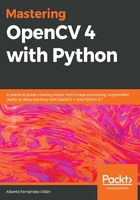
Contextualizing the reader
In order to contextualize the reader, it is necessary to establish and set the bases in relation to the main concepts concerning the theme of this book. The last few years have seen considerable interest in AI and machine learning, specifically in the area of deep learning. These terms are used interchangeably and very often confused with each other. For the sake of completeness and clarification, these terms are briefly described next.
AI refers to a set of technologies that enable machines – computers or robotic systems – to process information in the same way humans would.
The term AI is commonly used as an umbrella for a machine technology in order to provide intelligence covering a wide range of methods and algorithms. Machine Learning is the process of programming computers to learn from historical data to make predictions on new data. Machine learning is a sub-discipline of AI and refers to statistical techniques that machines use on the basis of learned interrelationships. On the basis of data gathered or collected, algorithms are independently learned by computers. These algorithms and methods include support vector machine, decision tree, random forest, logistic regression, Bayesian networks, and neural networks.
Neural Networks are computer models for machine learning that are based on the structure and functioning of the biological brain. An artificial neuron processes a plurality of input signals and, in turn, when the sum of the input signals exceeds a certain threshold value, signals to further adjacent neurons will be sent. Deep Learning is a subset of machine learning that operates on large volumes of unstructured data, such as human speech, text, and images. A deep learning model is an artificial neural network that comprises multiple layers of mathematical computation on data, where results from one layer are fed as input into the next layer in order to classify the input data and/or make a prediction.
Therefore, these concepts are interdependent in a hierarchical way, AI being the broadest term and deep learning the most specific. This structure can be seen in the next diagram:

Computer vision is an interdisciplinary field of Artificial Intelligence that aims to give computers and other devices with computing capabilities a high-level understanding from both digital images and videos, including functionality for acquiring, processing, and analyzing digital images. This is why computer vision is, partly, another sub-area of Artificial Intelligence, heavily relying on machine learning and deep learning algorithms to build computer vision applications. Additionally, Computer vision is composed of several technologies working together—Computer graphics, Image processing, Signal processing, Sensor technology, Mathematics, or even Physics.
Therefore, the previous diagram can be completed to introduce the computer vision discipline:
